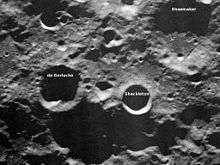Crater of eternal darkness
A crater of eternal darkness is a depression on a body in the Solar System within which lies a point that is always in darkness.

A related term is permanently shadowed regions.[1][2] As of 2019, there are 324 known permanently shadowed regions on the Moon.[3]
Location
Such a crater must be located at high latitude (close to a pole) and be on a body with very small axial tilt.
On the Moon, permanent shadow can exist at latitudes as low as 58°; approximately 50 permanently shadowed regions exist in the 58°- 65° latitude range for both lunar hemispheres.[6]
Conditions inside craters
Craters of eternal darkness might be advantageous for space exploration and colonization, as they preserve sources of water ice[7] that can be converted into drinkable water, breathable oxygen, and rocket propellant.[8] A business case analysis indicates that mining of propellants in the craters could become a profitable commercial enterprise.[9]
Several of such craters show indications of water ice in their interiors, including Rozhdestvenskiy[10] and Cabeus craters[11] on the Moon, and Juling Crater on Ceres[12].

In some cases, peaks of eternal light are located nearby, that could be advantageous for solar power generation. For example, there are 2 peaks near Shackleton Crater that are illuminated a combined ~94% of a lunar year.[13]
Permanently shadowed regions have a stable surface temperature. On the Moon, the temperature hovers somewhere at or below 50 degrees Kelvin.[14] Another temperatures estimate is 25 K to 70 K.[15] The low temperatures make the regions desirable locations for future infrared telescopes.[16][17]
On the other hand, computer simulations show that powerful solar storms can charge up the soil in permanently shadowed regions near the lunar poles, and may possibly produce "sparks" that could vaporize and melt the soil[18][19].
There are other unique challenges of such regions: a dark environment that restrict the ability of rovers to perceive the surroundings, cryogenic regolith that could be hard to move on, and communication interruptions.[20]
Planetary protection
In 2020, NASA has assigned "sensitive location" status to the Moon's permanently shadowed regions to avoid their contamination[21]
List
Below is an incomplete list of such craters:
The Moon:
Mercury:
- Petronius crater[27]
Many such craters also exist on Ceres.[28]. One example is Juling Crater, which is in almost permanent shadow.[29]
Research missions
Past
In 2009, LCROSS sent an impactor into a Cabeus crater, that resulted in detection of water in the ejected material.[30]
In 2012, The Lyman Alpha Mapping Project aboard NASA's Lunar Reconnaissance Orbiter has found that the permanently shadowed regions have a porous, powdery surface, that indicates the presence of water ice[31].
In 2018, an analysis of the results of the Moon Mineralogy Mapper confirmed the existence of water ice deposits in permanently shadowed craters and crevices, with more abundance near the south pole[32].
Planned
The proposed International Lunar Observatory mission involves a landing near the Malapert crater.[33]
Lunar Flashlight is planned to launch in 2021 as a secondary payload for the Artemis 1 mission.[34][35]
A camera called ShadowCam is being built that will be able to take high-resolution images of Permanently Shadowed Regions. It is a NASA instrument that will fly on board the Korea Pathfinder Lunar Orbiter (KPLO) in 2022.[36]
References
- https://lunar.gsfc.nasa.gov/images/lithos/LRO%20litho5-shadowedFinal.pdf
- https://svs.gsfc.nasa.gov/11218
- http://lroc.sese.asu.edu/psr/list
- https://www.planetary.org/space-images/permanently-shadowed-radar-bright-mercury
- Schorghofer, Norbert; Mazarico, Erwan; Platz, Thomas; Preusker, Frank; Schröder, Stefan E.; Raymond, Carol A.; Russell, Christopher T. (2016). "The permanently shadowed regions of dwarf planet Ceres". Geophysical Research Letters. 43 (13): 6783–6789. doi:10.1002/2016GL069368.
- https://meetingorganizer.copernicus.org/EPSC2012/EPSC2012-756.pdf
- https://www.space.com/41554-water-ice-moon-surface-confirmed.html
- https://web.archive.org/web/20060213061216/http://www.space.com/scienceastronomy/solarsystem/moon_mountain_020326.html
- https://www.liebertpub.com/doi/pdf/10.1089/space.2019.0002
- Mitchell, Julie (2017). "Investigations of Water-Bearing Environments on the Moon and Mars". Bibcode:2017PhDT.......229M. Cite journal requires
|journal=(help) - https://web.archive.org/web/20100122233405/http://www.planetary.org/news/2009/1113_LCROSS_Lunar_Impactor_Mission_Yes_We.html
- https://www.nasa.gov/feature/jpl/nasa-dawn-reveals-recent-changes-in-ceres-surface
- Bussey D. B. J., McGovern J. A., Spudis P. D., Neish C. D., Noda H., Ishihara Y., Sørensen S.-A. (2010). "Illumination conditions of the south pole of the Moon derived using Kaguya topography". Icarus. 208 (2): 558–564. Bibcode:2010Icar..208..558B. doi:10.1016/j.icarus.2010.03.028.CS1 maint: multiple names: authors list (link)
- http://lroc.sese.asu.edu/posts/96
- http://lroc.sese.asu.edu/posts/979
- https://science.nasa.gov/science-news/science-at-nasa/2008/09oct_liquidmirror/
- https://web.archive.org/web/20060213061216/http://www.space.com/scienceastronomy/solarsystem/moon_mountain_020326.html
- http://thescienceexplorer.com/universe/solar-storms-could-spark-soils-moons-poles
- https://www.semanticscholar.org/paper/Deep-dielectric-charging-of-regolith-within-the-Jordan-Stubbs/435f72e106b79692c11c71aba998c96638f3ff39
- https://www.nasa.gov/content/roving-in-the-permanently-shadowed-regions-of-planetary-bodies/
- https://www.businessinsider.in/science/space/news/nasa-new-rules-to-protect-mars-and-moon-from-earth-germs/articleshow/76906055.cms.
- http://lroc.sese.asu.edu/posts/96
- http://lroc.sese.asu.edu/posts/979
- Sanin, A. B.; Mitrofanov, I. G.; Litvak, M. L.; Malakhov, A.; Boynton, W. V.; Chin, G.; Droege, G.; Evans, L. G.; Garvin, J.; Golovin, D. V.; Harshman, K.; McClanahan, T. P.; Mokrousov, M. I.; Mazarico, E.; Milikh, G.; Neumann, G.; Sagdeev, R.; Smith, D. E.; Starr, R. D.; Zuber, M. T. (2012). "Testing lunar permanently shadowed regions for water ice: LEND results from LRO". Journal of Geophysical Research: Planets. 117: n/a. doi:10.1029/2011JE003971. hdl:2060/20140005994.
- Sanin, A. B.; Mitrofanov, I. G.; Litvak, M. L.; Malakhov, A.; Boynton, W. V.; Chin, G.; Droege, G.; Evans, L. G.; Garvin, J.; Golovin, D. V.; Harshman, K.; McClanahan, T. P.; Mokrousov, M. I.; Mazarico, E.; Milikh, G.; Neumann, G.; Sagdeev, R.; Smith, D. E.; Starr, R. D.; Zuber, M. T. (2012). "Testing lunar permanently shadowed regions for water ice: LEND results from LRO". Journal of Geophysical Research: Planets. 117: n/a. doi:10.1029/2011JE003971. hdl:2060/20140005994.
- https://web.archive.org/web/20060213061216/http://www.space.com/scienceastronomy/solarsystem/moon_mountain_020326.html
- https://www.nasa.gov/mission_pages/messenger/multimedia/messenger_orbit_image20121015_1.html
- Schorghofer, Norbert; Mazarico, Erwan; Platz, Thomas; Preusker, Frank; Schröder, Stefan E.; Raymond, Carol A.; Russell, Christopher T. (2016). "The permanently shadowed regions of dwarf planet Ceres". Geophysical Research Letters. 43 (13): 6783–6789. doi:10.1002/2016GL069368.
- https://www.jpl.nasa.gov/spaceimages/details.php?id=PIA21918
- https://web.archive.org/web/20100122233405/http://www.planetary.org/news/2009/1113_LCROSS_Lunar_Impactor_Mission_Yes_We.html
- https://www.space.com/14284-moon-permanently-shadowed-regions-water-ice.html
- https://www.space.com/41554-water-ice-moon-surface-confirmed.html
- https://www.spaceflightinsider.com/missions/space-observatories/international-lunar-observatory-new-astrophysical-perspective/
- https://www.space.com/27388-nasa-moon-mining-missions-water.html
- https://arstechnica.com/science/2019/07/nasas-large-sls-rocket-unlikely-to-fly-before-at-least-late-2021/
- http://lroc.sese.asu.edu/posts/979
